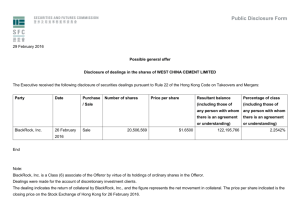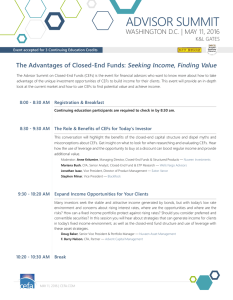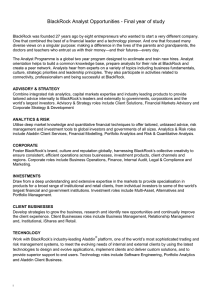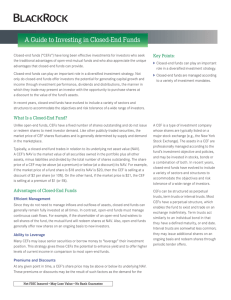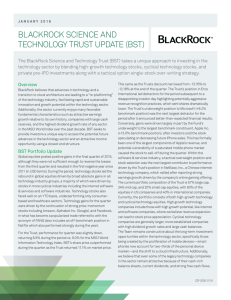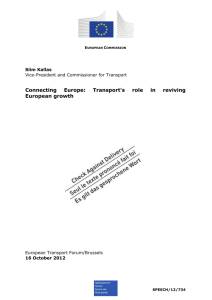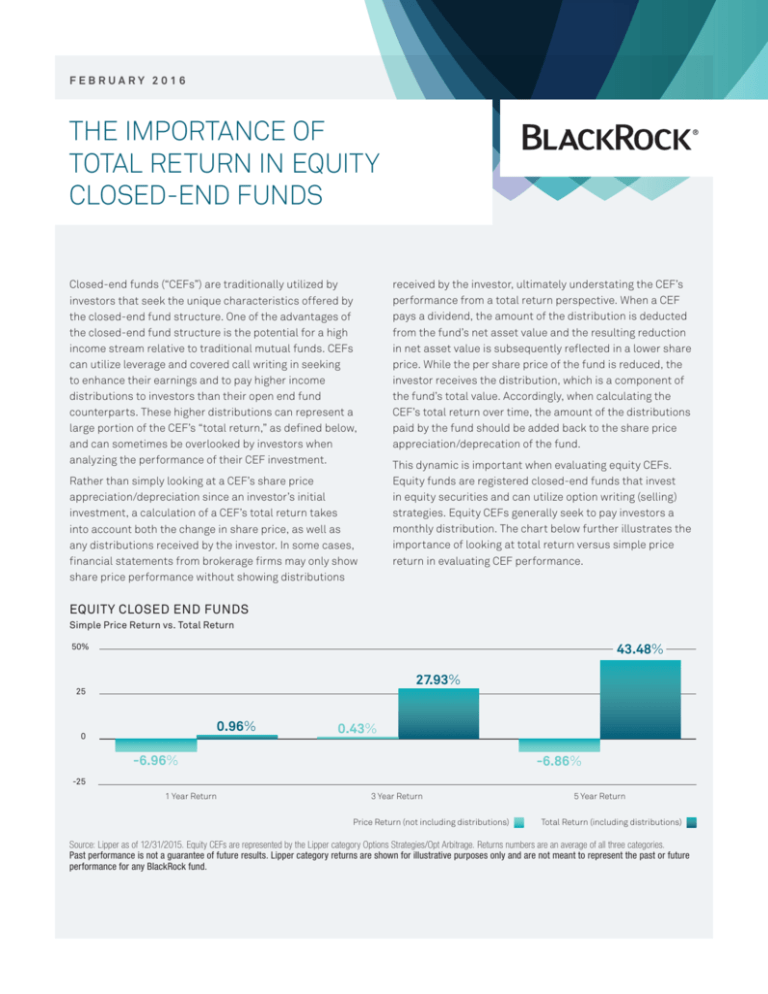
FEBRUARY 2016
THE IMPORTANCE OF
TOTAL RETURN IN EQUITY
CLOSED-END FUNDS
received by the investor, ultimately understating the CEF’s
performance from a total return perspective. When a CEF
pays a dividend, the amount of the distribution is deducted
from the fund’s net asset value and the resulting reduction
in net asset value is subsequently reflected in a lower share
price. While the per share price of the fund is reduced, the
investor receives the distribution, which is a component of
the fund’s total value. Accordingly, when calculating the
CEF’s total return over time, the amount of the distributions
paid by the fund should be added back to the share price
appreciation/deprecation of the fund.
Closed-end funds (“CEFs”) are traditionally utilized by
investors that seek the unique characteristics offered by
the closed-end fund structure. One of the advantages of
the closed-end fund structure is the potential for a high
income stream relative to traditional mutual funds. CEFs
can utilize leverage and covered call writing in seeking
to enhance their earnings and to pay higher income
distributions to investors than their open end fund
counterparts. These higher distributions can represent a
large portion of the CEF’s “total return,” as defined below,
and can sometimes be overlooked by investors when
analyzing the performance of their CEF investment.
This dynamic is important when evaluating equity CEFs.
Equity funds are registered closed-end funds that invest
in equity securities and can utilize option writing (selling)
strategies. Equity CEFs generally seek to pay investors a
monthly distribution. The chart below further illustrates the
importance of looking at total return versus simple price
return in evaluating CEF performance.
Rather than simply looking at a CEF’s share price
appreciation/depreciation since an investor’s initial
investment, a calculation of a CEF’s total return takes
into account both the change in share price, as well as
any distributions received by the investor. In some cases,
financial statements from brokerage firms may only show
share price performance without showing distributions
EQUITY CLOSED END FUNDS
Simple Price Return vs. Total Return
43.48%
50%
27.93%
25
0.96%
0
0.43%
-6.96%
-6.86%
-25
1 Year Return
3 Year Return
Price Return (not including distributions)
5 Year Return
Total Return (including distributions)
Source: Lipper as of 12/31/2015. Equity CEFs are represented by the Lipper category Options Strategies/Opt Arbitrage. Returns numbers are an average of all three categories.
Past performance is not a guarantee of future results. Lipper category returns are shown for illustrative purposes only and are not meant to represent the past or future
performance for any BlackRock fund.
WHY BLACKROCK®
BlackRock helps millions of people, as well as the world’s largest institutions and governments, pursue their
investing goals. We offer:
} A comprehensive set of innovative solutions
} Global market and investment insights
} Sophisticated risk and portfolio analytics
We work only for our clients, who have entrusted us with managing $4.6 trillion*, earning BlackRock the distinction of
being trusted to manage more money than any other investment firm in the world.
* AUM as of 12/31/15.
Performance data quoted represents past performance of common shares and does not guarantee future results. Investment
return and principal value of an investment will fluctuate so that an investor’s shares may be worth more or less than the original
cost. A fund’s market price and net asset value will fluctuate with market conditions. All return data assumes reinvestment of all
distributions. Current performance may be lower or higher than the performance data quoted. In evaluating total return, investors
should take into account the effect of federal, state and local income and other taxes payable by the investor on distributions
received from a fund and any gain on the sale of fund shares. The extent and nature of such taxes may be affected by a fund’s
particular investment strategies and tax status, as well as the investor’s own circumstances. Additional information regarding
distributions can be found in a fund’s annual and semi-annual shareholder report. For more information, please refer to
blackrock.com.
Closed-end fund shares are not deposits or obligations of, or guaranteed by, any bank and are not insured by the FDIC or any
other agency. Investing involves risk, including possible loss of principal amount invested. A closed-end fund that writes covered
calls over its portfolio in order to enhance distributions to shareholders, limits its ability to benefit from capital appreciation. As a
means of enhancing return, many fixed income closed-end funds may issue senior securities or borrow money to “leverage” their
investment position. There is no assurance that a fund’s leveraging strategy will be successful. Once a portfolio is leveraged, the
net asset value and market value of the common shares will be more volatile. While a common investment practice by many CEF
managers, leverage cannot assure a higher yield or return to the holders of the common shares. This is not a prospectus intended
for use in the purchase or sale of any fund’s shares. Investors should review a fund’s prospectus and other publicly available
information, including shareholder reports, carefully before investing. Shares may only be purchased or sold through registered
broker/dealers. For more information regarding any of BlackRock’s closed-end funds, please call BlackRock at 800-882-0052.
No assurance can be given that a fund will achieve its investment objective.
The market value and net asset value (NAV) of a fund’s shares will fluctuate with market conditions. Closed-end funds may trade
at a premium to NAV but often trade at a discount.
FOR MORE INFORMATION: blackrock.com
©2016 BlackRock, Inc. All Rights Reserved. BLACKROCK and INVESTING FOR A NEW WORLD are registered trademarks of BlackRock, Inc. or its subsidiaries in the United States and
elsewhere. All other trademarks are those of their respective owners.
Not FDIC Insured • May Lose Value • No Bank Guarantee
2265A-CEF-0216 / CEF-0080-0216

